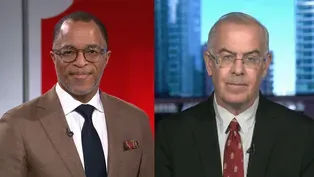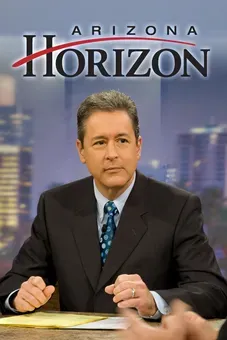
What you need to know ahead of Monday's total solar eclipse
Clip: 4/5/2024 | 7m 21sVideo has Closed Captions
What you need to know ahead of next week’s total solar eclipse
We’re less than three days away from the total solar eclipse that will be seen in the U.S., Mexico and Canada. Monday’s eclipse will cut across 13 states with more than 30 million people living in the path of totality while millions more are traveling to get a good look. Science correspondent Miles O’Brien and astrophysicist Neil DeGrasse Tyson have a viewer’s guide on what you need to know.
Problems with Closed Captions? Closed Captioning Feedback
Problems with Closed Captions? Closed Captioning Feedback
Major corporate funding for the PBS News Hour is provided by BDO, BNSF, Consumer Cellular, American Cruise Lines, and Raymond James. Funding for the PBS NewsHour Weekend is provided by...

What you need to know ahead of Monday's total solar eclipse
Clip: 4/5/2024 | 7m 21sVideo has Closed Captions
We’re less than three days away from the total solar eclipse that will be seen in the U.S., Mexico and Canada. Monday’s eclipse will cut across 13 states with more than 30 million people living in the path of totality while millions more are traveling to get a good look. Science correspondent Miles O’Brien and astrophysicist Neil DeGrasse Tyson have a viewer’s guide on what you need to know.
Problems with Closed Captions? Closed Captioning Feedback
How to Watch PBS News Hour
PBS News Hour is available to stream on pbs.org and the free PBS App, available on iPhone, Apple TV, Android TV, Android smartphones, Amazon Fire TV, Amazon Fire Tablet, Roku, Samsung Smart TV, and Vizio.
Providing Support for PBS.org
Learn Moreabout PBS online sponsorshipGEOFF BENNETT: We are less than three days away from the total solar eclipse that will be seen in the U.S., Mexico and Canada, and there is major excitement around it.
Total solar eclipses are rarely seen in the U.S.
The next one won't be seen for some 20 years, and they rarely last as long as this one will.
Complete darkness, or totality, as it's known, may last four minutes.
Monday's eclipse will cut across 13 states with more than 30 million people living in the path of totality.
Millions more are traveling to get a good look, and stores are selling or in some cases giving away the glasses you will need.
Our science correspondent, Miles O'Brien, has a viewer's guide on what you need to know.
MILES O'BRIEN: This is the one and only total solar eclipse I have ever witnessed, 2017.
I was prepared to be blase, but, instead, I was blown away.
You just have to see it to understand.
Certainly, this guy does.
Will there be a big viewing party here?
NEIL DEGRASSE TYSON, Director, Hayden Planetarium: Yes, there's a huge viewing party.
MILES O'BRIEN: Neil deGrasse Tyson is an astrophysicist at the American Museum of Natural History in New York City.
This eclipse, as much as anything, is about how many people can get to it, right?
NEIL DEGRASSE TYSON: The eclipse itself goes over major metropolitan areas.
It kisses part of Austin, goes through Dallas, right on up to major cities.
You got Columbus, Indianapolis, Buffalo, Niagara Falls.
People can sit in their backyards and experience a total solar eclipse without even having to travel.
MILES O'BRIEN: What would you recommend people do?
Should they get in their cars and go?
NEIL DEGRASSE TYSON: Yes.
(LAUGHTER) NEIL DEGRASSE TYSON: Yes, next question.
(LAUGHTER) MILES O'BRIEN: Done.
NEIL DEGRASSE TYSON: If you were in a place, in a zone where the moon has covered 99 percent of the sun, that little sliver that remains is equivalent to the light of 10,000 full moons.
So if you were not in totality, you're not in totality.
MILES O'BRIEN: I think we intuitively know the moon is a lot smaller than the sun.
So how is it, Neil... NEIL DEGRASSE TYSON: Yes, physically a lot smaller.
MILES O'BRIEN: Yes.
How is it possible for it to cover the entire diameter of the sun?
NEIL DEGRASSE TYSON: Yes, so we have a fortunate set of circumstances as Earthlings.
No other planet has this feature.
The sun is 400 times farther away from us than the moon is and it's 400 times wider.
Those two factors geometrically cancel each other, if you want to think of it that way, so that they look the same size on the sky, making for spectacular eclipses.
MILES O'BRIEN: OK, so now we're seeing an eclipse from the International Space Station, 250 miles, give or take, above us.
NEIL DEGRASSE TYSON: Mm-hmm.
MILES O'BRIEN: And what are we seeing there?
NEIL DEGRASSE TYSON: Yes, so this is that darkened part of the moon's shadow crossing Earth's surface.
And you're seeing -- you get to see a fuzzy edge around there.
Notice, it's not a sharp boundary, because, if you're in that fuzzy edge, it means some of the sun is covered and the rest still is peeking out.
MILES O'BRIEN: Mm-hmm.
NEIL DEGRASSE TYSON: So it's got to -- it gets darker, but it's not totality.
MILES O'BRIEN: You don't want to look at the sun unless it's completely covered without some protection.
Tell us about that.
What could happen?
NEIL DEGRASSE TYSON: Well, you never want to look at the sun, all right?
MILES O'BRIEN: Right.
NEIL DEGRASSE TYSON: So -- without protection.
And during an eclipse, you have more of an urge to look at the sun, but these are especially designed to filter out or reflect away all the harmful rays that are coming from the sun.
So when you put this on, you know they're working when you can't see anything.
I don't see -- are you...
MILES O'BRIEN: I got nothing.
I got nothing.
I got nothing.
NEIL DEGRASSE TYSON: Where are you?
OK?
MILES O'BRIEN: Yes, yes, yes, nothing, nothing.
NEIL DEGRASSE TYSON: You can't see anything.
NEIL DEGRASSE TYSON: But you look at the sun, and then there's an image of the sun on the sky.
MILES O'BRIEN: Yes.
You should look to make sure they're the proper ISO.
NEIL DEGRASSE TYSON: Oh, yes, yes.
So there's -- yes, an ISO certification on them.
NEIL DEGRASSE TYSON: And, generally, they will say eclipse glasses.
The moment the sun becomes completely covered, then you don't need the glasses.
You can remove them and look directly at the completely covered sun.
MILES O'BRIEN: I think this is an important, yet overlooked point.
Remember to take them off when it's in totality, right?
MILES O'BRIEN: Because, otherwise, you're missing out.
NEIL DEGRASSE TYSON: Then you're missing out, correct.
MILES O'BRIEN: So, in 2017, Celestron, telescope maker, shot this fabulous time-lapse...
MILES O'BRIEN: ... with the Celestron C6 telescope.
Look at this thing.
It came out pretty well.
NEIL DEGRASSE TYSON: Yes.
Yes.
Yes.
MILES O'BRIEN: So this is a preview, weather permitting.
NEIL DEGRASSE TYSON: Mm-hmm.
And it doesn't happen this fast.
This is time-lapse.
MILES O'BRIEN: This is much faster.
So, first contact is the moment the moon in its orbit around the sun touches the edge of the sun.
Second contact is when we hit the diamond ring, when this leading edge of the moon touches the opposite edge of the sun.
Diamond ring, second contact, OK?
Now the moon, which is larger than the sun on the sky, is continuing to move, when the trailing edge touches the sun again, the second diamond ring, that's third contact.
As the moon completely emerges from this disc of the sun and it steps off, that's fourth contact.
So there are four contacts of note.
And the ones you really care about are the second and third.
MILES O'BRIEN: All right.
And in between the second and third is when you can take the glasses off.
NEIL DEGRASSE TYSON: That's total eclipse.
That's correct.
MILES O'BRIEN: That's totality.
Your natural instinct is to look at the sun, but it's worth looking around and seeing what's happening all around you.
NEIL DEGRASSE TYSON: So, a tree with leaves, we have all sat under the trees like that before, and you see these modeled circles of light.
And it's very easy to think to yourself that's just light coming through the trees.
But it's actual images of the sun created by pathways through the leaves.
So, during an eclipse, all those little circles of light turn into crescents.
MILES O'BRIEN: But I think the point here is, take a moment to kind of look around you and absorb the environment.
The temperature changes.
There's kind of a -- there's a quietness that comes along with it.
MILES O'BRIEN: The birds and bees do different things.
NEIL DEGRASSE TYSON: The animals of -- you know, the animal kingdom are confused by this.
But I think, among all the animals, the ones that behave the strangest are the humans.
NEIL DEGRASSE TYSON: So, watch the behavior of other humans.
MILES O'BRIEN: Where would an expert like you go to watch this eclipse?
NEIL DEGRASSE TYSON: It happens that the eclipse goes not only over Dallas, but what is in Dallas but the Cotton Bowl, right?
This seats 90,000 people.
So what a convenient place to gather.
And this was being reserved by NOAA, the National Oceanic and Atmospheric Administration.
NEIL DEGRASSE TYSON: So if there's anyone has power over the weather, it would be them.
MILES O'BRIEN: And maybe they will make it happen for us.
MILES O'BRIEN: All right.
All right.
Thank you very much, Neil.
This has been fun.
MILES O'BRIEN: I hope you get to see it.
I hope we do too.
GEOFF BENNETT: Well, lucky for us, Miles will join us from the Cotton Bowl in Dallas on Monday, where he's going to report on the excitement around the day's events there and throughout North America.
Brooks and Capehart on acceptance of violence in politics
Video has Closed Captions
Brooks and Capehart on the acceptance of violence in U.S. politics (10m 40s)
Israel draws outrage after airstrikes kills 7 aid workers
Video has Closed Captions
Israel draws international outrage after airstrikes kills 7 aid workers (3m 46s)
Israel’s war in Gaza weighs on the holy month of Ramadan
Video has Closed Captions
Israel’s war in Gaza weighs on the holy month of Ramadan (4m)
Maryland Governor on complicated Baltimore bridge rebuilding
Video has Closed Captions
Maryland Gov. Moore on 'remarkably complicated' Baltimore bridge recovery and rebuilding (7m 43s)
Russia continues to link terrorist attack to Ukraine
Video has Closed Captions
Russia continues to link terrorist attack to Ukraine despite conflicting U.S. intelligence (5m 43s)
Sen. Coons explains new openness to conditions on Israel aid
Video has Closed Captions
Biden ally Sen. Chris Coons signals new openness to conditioning Israel aid (6m 24s)
Providing Support for PBS.org
Learn Moreabout PBS online sponsorshipSupport for PBS provided by:
Major corporate funding for the PBS News Hour is provided by BDO, BNSF, Consumer Cellular, American Cruise Lines, and Raymond James. Funding for the PBS NewsHour Weekend is provided by...

















